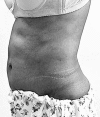Stiff person syndrome in South Asia
- PMID: 27756410
- PMCID: PMC5070143
- DOI: 10.1186/s13104-016-2276-z
Stiff person syndrome in South Asia
Abstract
Background: Stiff person syndrome is a highly disabling, progressive autoimmune disorder of the central nervous system characterized by muscle rigidity and spasms. Stiff person syndrome is rare, but is believed to be under diagnosed with only 14 cases been reported among a 1.7 billion population in South Asia. We report the first authenticated case from Sri Lanka.
Case presentation: A 55-year-old Sri Lankan female presented with difficulty in walking and recurrent falls due to progressive muscular rigidity in her lower limbs and trunk with superimposed muscle spasms that occurred in response to unexpected noise, startle or emotional upset. She had anxiety and specific phobias to open spaces, walking unaided and being among crowds of people. She had insulin-dependent diabetes mellitus and was on thyroxine replacement. On examination, she had hyperlordosis combined with board-like rigidity of her anterior abdomen and rigidity of her lower limbs bilaterally. Upper limbs were normal. Magnetic resonance imaging of her neuraxis was normal. Electromyography showed continuous motor unit activity at rest. Glutamic acid decarboxylase antibodies were detected in her serum at a titre of 15,500 IU/ml (normal <5). She showed a remarkable and sustained improvement to treatment with intravenous immunoglobulins, immunosuppressive and muscle relaxant medications, regaining independent ambulation.
Conclusions: Diagnosis of stiff person syndrome remains clinical, supported by electromyography and serology for glutamic acid decarboxylase antibodies, facilitated by a high index of clinical suspicion. An autoimmune basis lends stiff person syndrome amenable to treatment highlighting the importance of diagnosis. This case adds to map the worldwide distribution of stiff person syndrome.
Keywords: Autoimmune; CNS; Case report; GAD antibodies; Sri Lanka; Stiff person syndrome.
Figures
Similar articles
-
A Rare Case of Childhood Stiff Person Syndrome Associated With Pleuropulmonary Blastoma.Pediatr Neurol. 2015 Nov;53(5):448-51. doi: 10.1016/j.pediatrneurol.2015.06.015. Epub 2015 Jul 2. Pediatr Neurol. 2015. PMID: 26344328
-
Review of 23 patients affected by the stiff man syndrome: clinical subdivision into stiff trunk (man) syndrome, stiff limb syndrome, and progressive encephalomyelitis with rigidity.J Neurol Neurosurg Psychiatry. 1998 Nov;65(5):633-40. doi: 10.1136/jnnp.65.5.633. J Neurol Neurosurg Psychiatry. 1998. PMID: 9810930 Free PMC article.
-
The stiff-person syndrome. Case report.Minerva Anestesiol. 2002 Nov;68(11):861-5. Minerva Anestesiol. 2002. PMID: 12538969
-
Stiff-person syndrome: a case report and review of the literature.J Natl Med Assoc. 2010 Dec;102(12):1261-3. doi: 10.1016/s0027-9684(15)30757-4. J Natl Med Assoc. 2010. PMID: 21287911 Review.
-
Stiff-person syndrome: an atypical presentation and a review of the literature.Hosp Pract (1995). 2021 Dec;49(5):384-390. doi: 10.1080/21548331.2021.1961456. Epub 2021 Aug 20. Hosp Pract (1995). 2021. PMID: 34313523 Review.
Cited by
-
Is Stiff Person Syndrome Benefited by Physical Therapy Intervention? Summary of Case Reports.Biomed Res Int. 2019 Mar 24;2019:5613680. doi: 10.1155/2019/5613680. eCollection 2019. Biomed Res Int. 2019. PMID: 31019968 Free PMC article. Review.
-
Anti-glutamic acid decarboxylase 65: Related stiff person syndrome - A report of two cases and literature review.SAGE Open Med Case Rep. 2025 Apr 29;13:2050313X251333676. doi: 10.1177/2050313X251333676. eCollection 2025. SAGE Open Med Case Rep. 2025. PMID: 40308378 Free PMC article.
-
Neurophysiological Insights into the Pathophysiology of Stiff-Person Spectrum Disorders.Mov Disord Clin Pract. 2025 Apr;12(4):409-417. doi: 10.1002/mdc3.14328. Epub 2025 Jan 8. Mov Disord Clin Pract. 2025. PMID: 39778012 Free PMC article. Review.
References
-
- Moersch FP, Woltman HW. Progressive fluctuating muscular rigidity and spasm (“stiff-man” syndrome); report of a case and some observations in 13 other cases. Proc Staff Meet Mayo Clin. 1956;31(15):421–427. - PubMed
Publication types
MeSH terms
LinkOut - more resources
Full Text Sources
Other Literature Sources


